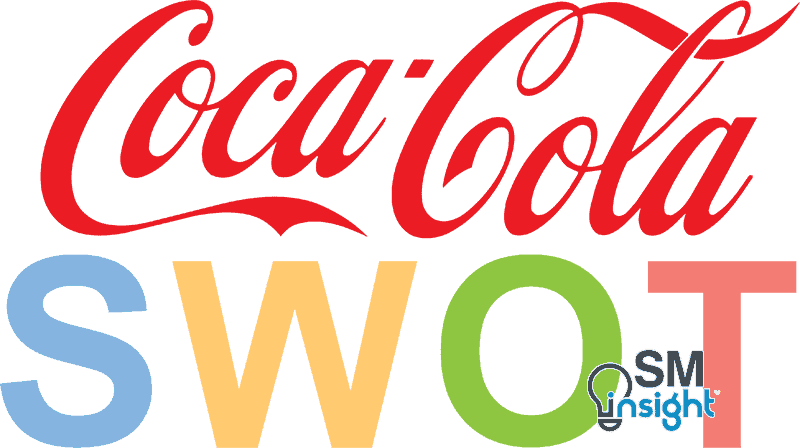This Coca Cola SWOT analysis reveals how the company controlling one of the most iconic brands of all time used its competitive advantages to become the world’s second largest beverage manufacturer.
It identifies all the key strengths, weaknesses, opportunities and threats that affect the company the most. If you want to find out more about the SWOT of Coca Cola, you’re in the right place.
Learn how to do a SWOT analysis.
Company Overview
| Name | The Coca-Cola Company |
|---|---|
| Founded | May 8, 1886 |
| Logo |  |
| Industries served | Beverage |
| Geographic areas served | Worldwide (more than 200 countries) |
| Headquarters | Atlanta, Georgia, United States |
| Current CEO | James Quincey |
| Revenue | $47.061 billion (2024) |
| Net Income | $10.631 billion (2024) |
| Employees | 69,700 (2024) |
| Main Competitors | PepsiCo Inc., Dr Pepper Snapple Group, Inc., Unilever Group, Mondēlez International, Inc., Groupe Danone, Kraft Foods Inc., Nestlé S.A. and many other companies in the beverage industry. |
Business Description
The Coca-Cola Company business overview from the company’s financial report:
“The Coca-Cola Company is the world’s largest beverage company. We own or license and market more than 500 nonalcoholic beverage brands, primarily sparkling beverages but also a variety of still beverages such as waters, enhanced waters, juices and juice drinks, ready-to-drink teas and coffees, and energy and sports drinks.
We own and market four of the world’s top five nonalcoholic sparkling beverage brands: Coca-Cola, Diet Coke, Fanta and Sprite. Finished beverage products bearing our trademarks, sold in the United States since 1886, are now sold in more than 200 countries.
We make our branded beverage products available to consumers throughout the world through our network of Company-owned or -controlled bottling and distribution operations as well as independent bottling partners, distributors, wholesalers and retailers — the world’s largest beverage distribution system.
Beverages bearing trademarks owned by or licensed to us account for 1.9 billion of the approximately 60 billion beverage servings of all types consumed worldwide every day.
We believe our success depends on our ability to connect with consumers by providing them with a wide variety of choices to meet their desires, needs and lifestyle choices. Our success further depends on the ability of our people to execute effectively, every day.
Our goal is to use our Company’s assets — our brands, financial strength, unrivaled distribution system, global reach, and the talent and strong commitment of our management and associates — to become more competitive and to accelerate growth in a manner that creates value for our shareowners.”[1]
You can find more information about the business in The Coca Cola Company’s official website or Wikipedia’s article.
Coca-Cola SWOT Analysis
| Strengths | Weaknesses |
|---|---|
| 1. Dominant market share in the beverage industry 2. Diversified product portfolio with 21 billion-dollar brand 3. The largest advertising budget among the competitors 4. The most recognizable beverage brand in the world 5. Strong partnerships with bottling companies leading to some of the most extensive distribution channels in the industry 6. A partnership with McDonald’s | 1. Strong reliance on carbonated soft drinks to generate the majority of the company’s revenue 2. Criticism over business practices |
| Opportunities | Threats |
|---|---|
| 1. Expansion of ready-to-drink (RTD) coffee products in the U.S. market 2. Growing tequila market with many smaller brands that can be easily acquired 3. Coconut water market is expected to reach US$8.3 billion by 2023 4. Savory snack market will see tremendous growth over the next 3 years 5. The declining U.S. dollar exchange rate could positively affect the company’s revenue and profits | 1. Obesity concerns may reduce demand for some of the company’s products 2. Extension of ‘soda tax’ to more cities or states in the U.S. 3. Water scarcity and its poor quality could negatively impact The Coca-Cola Company’s production costs and capacity 4. Increased competition and their capabilities could hurt The Coca-Cola Company’s business |
Strengths
1. Dominant market share in the beverage industry
The Coca-Cola Company is the largest non-alcoholic beverage company in the world. It serves 1.9 billion or 3.2% of the total 60 billion beverage servings of all types consumed worldwide every day.[1] The company owns, distributes and sells over 500 various non-alcoholic beverage brands in over 200 countries.
Figure 1. Largest beverage companies in the world in 2017
| Rank | Name | 2017 revenue (in US$ billions) | Beverage segment |
|---|---|---|---|
| 1. | Anheuser-Busch InBev | 56.444 | Alcoholic |
| 2. | The Coca-Cola Company | 35.410 | Non-alcoholic |
| 3. | PepsiCo Inc. | 29.857 | Non-alcoholic |
| 4. | Nestlé S.A. | 29.109 | Non-alcoholic |
| 5. | Suntory Holdings Limited | 22.057 | Alcoholic |
| 6. | Heineken N.V. | 21.888 | Alcoholic |
| 7. | Starbucks Corporation | 17.650 | Non-alcoholic |
| 8. | Diageo plc | 17.078 | Alcoholic |
| 9. | Pernod Ricard S.A. | 11.132 | Alcoholic |
| 10. | Molson Coors Brewing Co. | 11.002 | Alcoholic |
Source: Beverage Industry[2]
Only PepsiCo and Nestlé can compare to The Coca-Cola Company’s sheer size and the market share in the non-alcoholic beverage segment. Being large and having dominant market share has a few advantages over competitors:
- Economies of scale. Economies of scale allow the company to share its fixed costs over hundreds of brands and billions of servings, making each drink as cheap as possible.
- Market power over suppliers and competitors. Due to its size, The Coca-Cola Company can exercise its market power over suppliers by requiring lower prices from them. The company can also use its size to affect the competition by underpricing some of its items, acquiring the smaller competitors or saturating the market with many of its own products.
- Power over the buyers. Unlike some of its smaller competitors, the Coca-Cola brand and the company’s other signature drinks have an enormous brand recognition all over the world. The company can influence consumers’ buying decisions through its brand power and massive marketing campaigns more easily than most of its smaller rivals.
- Wide audience reach. The Coca-Cola Company’s distribution network allows the chain to reach more customers than most of its rivals could reach. According to the company, the company serves 1.9 billion servings a day, more than any other competitor in the world. Wide audience reach does not only help the company to target more customers and increase brand awareness, but also to introduce new products more easily.
2. Diversified product portfolio with 21 billion-dollar brand
The Coca-Cola Company owns and distributes over 500 different brands, which is the most extensive beverage brand portfolio in the whole industry. The company offers beverages for every taste in 7 beverage categories:
- Carbonated Soft Drinks
- Bottled Water
- Juice & Juice Drinks
- Sports Drinks
- Tea & Coffee
- Energy Drinks & Shots
- Alternative Drinks
Figure 2. Largest beverage brand portfolios
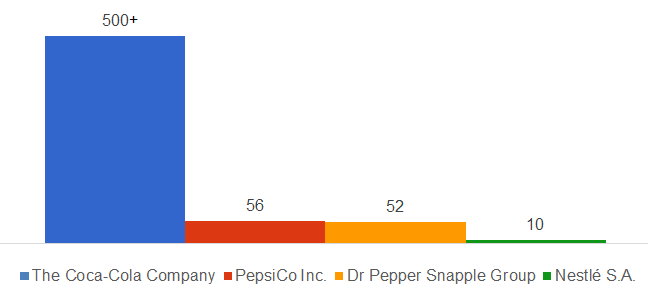
Source: Companies’ financial reports and official websites[3][4][5][6]
The most popular company’s drink is Coca-Cola. Coca-Cola trademark (includes Diet Coke, Coca-Cola Zero, Coca Cola Life and other beverages bearing Coca Cola name) accounted for 45 percent of the company’s worldwide unit case volume for 2017.[1] While Coca-Cola is the most important product, it is only one of the 21 billion-dollar brands that the business owns. The company’s billion-dollar brands include:
- Coca-Cola
- Fanta
- Sprite
- Diet Coke/Coca-Cola Light
- Coca-Cola Zero
- Minute Maid
- Georgia Coffee
- Powerade
- Del Valle
- Schweppes
- Aquarius
- Minute Maid Pulpy
- Dasani
- Simply
- Vitaminwater
- Gold Peak
- Fuze Tea
- Ice Dew
- smartwater
- I LOHAS
- Ayataka
Figure 3. The Coca-Cola Company’s billion-dollar brands

Source: The Coca-Cola Company[7]
No other business in the beverage industry owns as many billion-dollar brands as The Coca-Cola Company.
What does a diversified portfolio provide for the company? First, The Coca Cola Company depends less on one or two of its beverages to generate the majority of its revenue. Second, with so many beverage drinks in so many flavors, the business can satisfy every consumer’s needs and tastes. Third, if the demand for one of the company’s beverages falls sharply (as it is now with Coca-Cola) the business can rely on other beverages to generate higher sales.
Few of The Coca Cola Company’s rivals can enjoy such a diversified brand portfolio, which provides strong competitive advantage over the rivals.
3. The largest advertising budget among the competitors
The Coca-Cola Company’s annual advertising spending was US$3.958 billion, US$4.004 billion and US$3.976 billion in 2017, 2016 and 2015, respectively.[1] Advertising expenses accounted for 11.2% of total revenue last year. In 2017, The Coca-Cola Company was the largest advertiser in the beverage industry in the world.
Figure 4. The Coca-Cola Company and its competitors’ advertising expenses 2015-2017 (in US$ billions)
| Company | 2017 | 2016 | 2015 |
|---|---|---|---|
| The Coca-Cola Company | 3.976 | 4.004 | 3.499 |
| PepsiCo Inc. | 2.4 | 2.5 | 2.4 |
| Dr Pepper Snapple Group Inc. | 0.547 | 0.477 | 0.473 |
Source: The respective companies’ financial reports [1][4][5]
The company’s large advertising budget provides competitive advantages such as:
- helping to introduce new products to the market;
- promoting the brand;
- informing consumers about the product’s features;
- communicating the brand’s message to the public;
- increasing sales.
In addition, the company’s total marketing expenses reached US$6.2 billion (or 17.5% of total revenue in 2017), generating US$35.410 billion in revenue. It is one of the largest marketing budgets in the beverage industry.
With its largest advertising budget and strong marketing capabilities The Coca-Cola Company is able to attract more customers and generate higher sales than most of its rivals.
4. The most recognizable beverage brand in the world
The Coca Cola Company sold its first Coca-Cola drink in 1886.[7] Since then, the company has become the world’s largest non-alcoholic beverage company in terms of revenue with the most recognizable brand in the industry. According to Interbrand[8] and Forbes[9], Coca-Cola brand is 4th and 5th most valuable brand in the world, worth US$69.733 billion and US$56.4 billion, respectively. In addition to the Coca-Cola brand, the company distributes and markets other recognizable brands, most notably, Sprite. Interbrand[8] values Sprite brand as the 90th most valuable brand in the world, worth US$4.842 billion.
The brand value is closely related to the brand recognition. Usually, the more valuable a brand is the better it is recognized worldwide. The Coca-Cola company, which operates in over 200 countries, where billions of people live, enjoys some of the greatest brand awareness among all global corporations. Brand awareness also helps to introduce new products or sell the current ones faster as the company needs to spend less money on advertising.
Figure 5. The Coca-Cola Company’s brand value 2000-2017
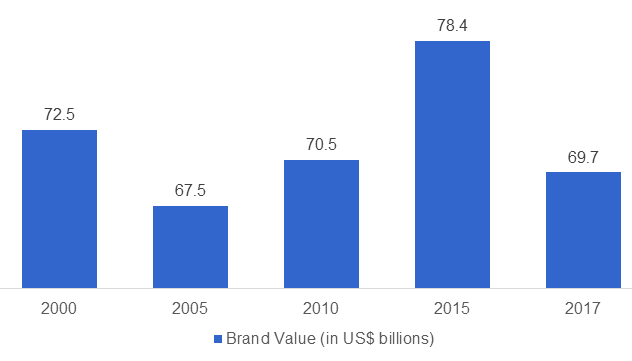
Source: Interbrand [8][10][11][12][13]
No other Coca-Cola Company’s rival have such a valuable and recognizable beverage brand strengthening the company.
5. Strong partnerships with bottling companies leading to some of the most extensive distribution channels in the industry
The Coca-Cola Company emphasizes its franchise leadership and its bottling and distribution operations as key capabilities and strengths.[1] The company’s business model relies on partners to bottle its syrups or concentrates into packages and to distribute, sell and market its products. Usually, only one bottling partner holds a license to sell and distribute The Coca-Cola Company’s products in a certain geographic area.
On the other hand, the bottling partners rely on The Coca-Cola Company to develop and introduce new products and to provide promotional and marketing services. If one of the bottling partners is underperforming in the market, the company usually invests in that partner to take control. The Coca-Cola Company then uses its expertise and resources to improve the partner’s performance before returning control back to the partner.
The Coca-Cola Company’s products are distributed and served in more than 200 countries. The company uses its bottling partners to distribute and sell its products worldwide, via what is known as the ‘Coca-Cola system’. This system sold 29.2, 29.3 and 29.2 billion unit cases (24 eight-ounce servings) of the company’s products in 2017, 2016 and 2015, respectively.
The Coca-Cola Company’s five largest bottling partners (Coca-Cola FEMSA, Coca-Cola European Partners plc, Coca-Cola Hellenic, Arca Continental and Coca-Cola İçecek) account for 41% of the company’s total unit case volume. These bottlers distribute the company’s beverages to over 50 countries.
Except PepsiCo, no other company can match The Coca-Cola Company’s extensive distribution network.
6. A partnership with McDonald’s
The Coca-Cola Company does business with many restaurants, but its relationship with McDonald’s is unique. McDonald’s is the only client that has its own division inside The Coca-Cola Company, making it the most important client for the company. According to Gelles from the New York Times[17], no restaurant can sell Coca-Cola drinks for a lower price than McDonald’s, even if that means losing the customer to PepsiCo.
The Coca-Cola Company doesn’t reveal how many of its sales come from McDonald’s restaurants, but its employees state that sales from McDonald’s are only behind sales from the U.S., Japan and Germany.[17]
While such a relationship is a weakness during the years when McDonald’s sales decline, it becomes a strength during growth years. For the last 3 years, McDonald’s Systemwide sales increased from US$66.226 billion to US$78.191 billion,[35] which means higher sales for The Coca-Cola Company.
This situation is likely to continue in the near future, making it easier for the company to grow its sales.
Weaknesses
1. Strong reliance on carbonated soft drinks to generate the majority of the company’s revenue
In 2017, The Coca-Cola Company earned US$35.410 billion of which at least 70% or over US$24 billion were earned through selling various carbonated soft beverages. Carbonated soft drinks (CSD) represented 69 percent, 69 percent and 70 percent of the company’s worldwide unit case volume for 2017, 2016 and 2015, respectively. Of the U.S. unit case volume, 62 percent was attributable to CSD and 38 percent to still beverages.
Figure 6. Worldwide unit case volume share by product category
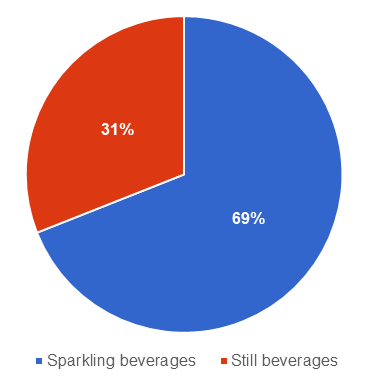
Source: The Coca-Cola Company financial report[1]
Currently, the demand for CSD is declining considerably in the U.S., which is the company’s single largest market. Due to the various studies that stress the negative health effects from drinking sugary sparkling beverages,[14] consumers’ preferences are shifting from CSD to low calorie unsweetened beverages, such as water, tea and coffee.
According to Beverage Marketing Corporation data,[15] the market for CSD has been declining for the past 11 years. In 2006, an average U.S. consumer drank 50.4 gallons of CSD per year. In 2017, this number declined by 25.6% to 37.5 gallons.[15] The report also indicates that CSD market will likely continue to decline over the next few years as well.
The declining demand for CSD is the major company’s weakness as it heavily relies on carbonated soft drinks such as Coca-Cola, Diet Coke, Sprite and Fanta for the majority of the sales. The company’s rivals, which rely less on CSD for their revenue, are less affected by the changing customer preferences.
In order to return to growth, The Coca-Cola Company should minimize its dependence on sparkling beverages and heavily invest into and market still beverages, which are more profitable for the company and healthier for consumers.
2. Criticism over business practices
The company receives a lot of criticism from various groups, governments and consumers over its business and environmental practices, such as:
- the impact of its products on obesity
- questionable advertising and marketing practices
- its policies towards the environment
- lobbying and ‘bribing’ government officials and health organizations
- high water usage
- monopolistic business practices
While the Coca-Cola isn’t the only beverage company receiving criticism for its business practices, it’s size and impact on the industry draws the most attention. In recent years, The Coca-Cola Company has improved its business and environmental practices and has seen less criticism for it, but its reputation still suffers from previous scandals.
In 2015, it has been criticized for funding a research, which argued that people should exercise more instead of cutting their calorie intake.[16] The research was trying to shift the responsibility away from the various foods and beverages that added to obesity.
Such criticism of a business results in negative publicity, which damages a company’s brand reputation and its sales.
Opportunities
1. Expansion of ready-to-drink (RTD) coffee products in the U.S. market
According to the Beverage Marketing Corporation Report, the fastest growing liquid beverage segment in the U.S. during 2013-2017 was RTD coffees.[18][19][20][21] In 2017, RTD coffees was the fastest growing beverage segment in the U.S. beverage industry, growing by an impressive 12.3%.[22] The RTD coffee segment grew 6 times faster than the entire U.S. liquid beverage market, which grew by 2.1% only in 2017.
Figure 7. RTD coffee growth compared to the growth of the whole liquid beverage market in the U.S.

Source: Beverage Marketing Corporation[18][19][20][21][22]
While, the beverage industry as a whole grew only by 11.3%, RTD coffees grew by a staggering 70.7% over the last 5 years.
In 1975, The Coca-Cola Company’s subsidiary in Japan launched RTD coffee brand, named Georgia, into the market. Georgia became a success in Japan and the company introduced the brand to the U.S. in 2009. These coffees currently mainly sell to Asians in the United States. The company also expanded its Gold Peak RTD tea brand, which offers cold-brew RTD coffee as well. In addition to its own brands, The Coca-Cola Company now sells Dunkin’ Donuts Iced Coffee beverages across the U.S.
Although the segment is relatively small, The Coca-Cola Company could further promote its Georgia brand in the U.S. market to establish itself as the RTD coffee leader in its home country. There are also many smaller growing RTD coffee brands that could be easily acquired and would increase the company’s RTD coffee portfolio and the market share in the RTD coffee market.
2. Growing tequila market with many smaller brands that can be easily acquired
The Coca-Cola Company almost exclusively operates only in a non-alcoholic beverage (it has launched its first alcoholic drink in Japan called “Chu-Hi” in 2018) market, which at the moment is growing slowly. The company already operates in every segment of the non-alcoholic beverage industry and faces stiff competition in each product category. There is little room for Coca-Cola to grow its beverage business and do it fast.
Another growing opportunity for the company is to venture into an alcohol industry (we suggested this opportunity back in 2015). An alcohol industry grew by 1.7% in the U.S. in 2017.[23] It was an eighth consecutive year of growth in the market. The market is worth around US$80 billion in the U.S. alone. An alcohol market is huge with many different segments in the market, including:
- Malts (beer, cider);
- Wines (table wines, champagne, sparkling wines);
- Spirits (vodka, whisky, rum, tequila, brandy, gin).
Currently, one of the fastest growing alcohol industry’s segment is tequila. Tequila sales grew by 9.9% in 2017 [24] to US$2.7 billion. The market for tequila is expected to be worth US$8 billion in the Americas (including North and South America) by 2021. [25] There are many smaller brands in the market that could be acquired easily.
Figure 8. Top-selling tequila brands in the U.S. in 2017
| Rank | Brand | Volume sold (in millions of cases) |
|---|---|---|
| 1. | Jose Cuervo | 3.515 |
| 2. | Patron | 2.475 |
| 3. | Sauza | 2.247 |
| 4. | 1800 | 1.090 |
| 5. | Familia Camerena | 0.785 |
| 6. | Juarez | 0.695 |
| 7. | Montezuma Tequila | 0.630 |
| 8. | El Jimador | 0.516 |
| 9. | Don Julio | 0.357 |
| 10. | Margaritaville | 0.305 |
Source: Statista[26]
The Coca-Cola Company could expand its product offerings by venturing into the alcoholic beverages market. By leveraging its expertise in producing and selling beverages the company could easily increase its revenue and diversify its portfolio.
3. Coconut water market is expected to reach US$8.3 billion by 2023
Consumer trend for healthy beverages have pushed the water market growth to the new levels. According to Beverage Marketing Corporation, [15] volume sales of bottled water grew by 7% in 2017. This allowed water to become the most popular beverage category in the U.S. for the second consecutive year.[15] One of the subcategories that pushed the bottled water to the No.1 spot in the beverages was a growing demand for plant-based waters, mostly coconut water.
Consumers, who are looking for the alternatives to healthy hydration often choose plant based waters, which offer better flavor, natural ingredients and less sugar. Plant-based water market is dominated by coconut water, which is experiencing a significant growth both globally and in the U.S. By various estimates, coconut water market is expected to grow from US$2.4 to US$8.3 billion globally by 2023.[27][28]
The Coca-Cola Company currently owns ZICO coconut water brand, which is the leader in coconut water market.[29] Nonetheless, PepsiCo is trying to dominate the market with its own O.N.E. coconut water brand and a potential acquisition of Vita Coco, another leading coconut water brand.
Therefore, The Coca-Cola Company should try to increase its efforts to dominate this niche market, which the potential to become a very significant market in 5-10 years.
4. Savory snack market will see tremendous growth over the next three years
Since its inception in 1886, The Coca-Cola Company has been selling only beverages to its customers. Due to the declining sales of its main carbonates soft drinks, Coca Cola has little room to grow its beverage business in the current beverage market. The company has to find new growth venues in other markets. Therefore, it could venture into the market closest to the beverages – snacks. PepsiCo is selling snacks in addition to the beverages and sees a significant success due to the ability to cross-sell beverages and snacks. Out of the 22 billion dollar brands that PepsiCo owns, 7 are savory snack brands.[30]
That’s the market The Coca-Cola Company has an opportunity to invest in. According to Euromonitor International,[31] the savory snack market was worth US$46 billion in the U.S. in 2016 and is expected to reach US$50 billion in 2021. That’s US$4 billion growth in just 5 years. The report from Euromonitor International also predicts that global savory snack market will see even faster growth than the U.S. market.
Figure 9. Comparison of savory snack market share by regions
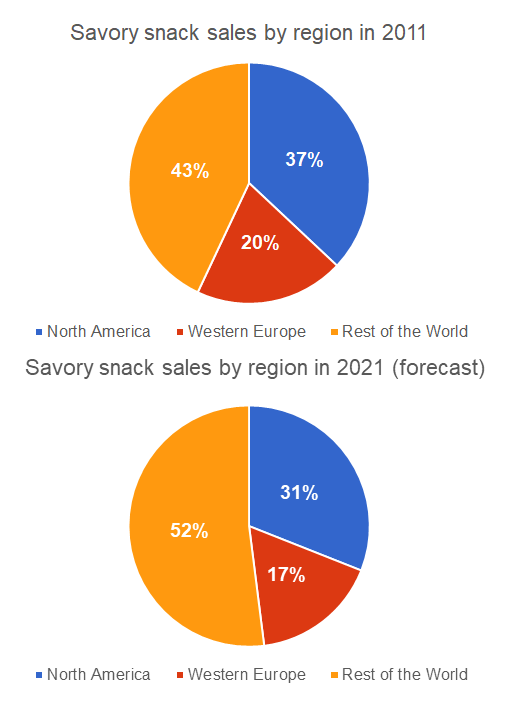
Source: Euromonitor International [31]
The Coca-Cola Company has never sold food or a snack product, but it has many advantages over the rivals in the market. First, it has the skills in manufacturing, marketing, managing supply chain and a huge advertising budget. In addition, the company’s debt isn’t extremely huge and while the capital is still cheap, the company has many opportunities to acquire smaller but growing savory snack brands.
Coca Cola Company’s move to the savory snack industry would allow to diversify its portfolio even further and would increase the company’s sales.
5. The declining U.S. dollar exchange rate could positively affect the company’s revenue and profits
Currency exchange rates affect every multinational company, including The Coca-Cola Company. In 2017, the company earned US$20.683 billion or 58.4% of its revenue outside of the U.S.[1]
Figure 10. The Coca-Cola Company’s geographic revenues
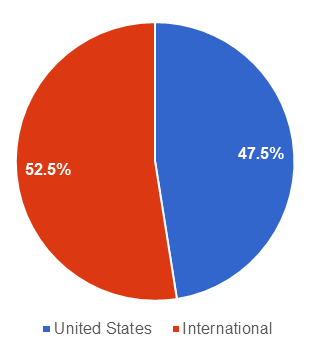
Source: Company’s financial report[1]
This means that The Coca-Cola Company currently receives the majority of its profits in currencies other than the U.S. dollar. Other currencies therefore have to be converted to the U.S. dollar in order for the company to be able to calculate its total revenue and transfer its profits back to the U.S. This is where a weak U.S. dollar, or in other words, the currently declining U.S. dollar exchange rate is a financial opportunity for the company.
A weak dollar does not only increase the profits from foreign countries but also makes the company’s products cheaper and more attractive to the customers abroad. It also provides an opportunity for The Coca-Cola Company to expand its sales outside of the U.S. and diversify its geographic revenue.
In 2017, the U.S. dollar declined in value against other currencies for the first time in 5 years. Current forecasts indicate that the U.S. dollar exchange rate is going to continue to decline against other currencies in 2018 as well. This means that The Coca-Cola Company’s products will become even cheaper abroad and its revenue and profits from outside the country are likely to increase when converted to U.S. dollars.
Threats
1. Obesity concerns may reduce demand for some of the company’s products
According to The Coca-Cola Company’s financial report[1], obesity concerns are the no.1 threat that is affecting the company:
“There is growing concern among consumers, public health professionals and government agencies about the health problems associated with obesity. Increasing public concern about obesity; other health-related public concerns surrounding consumption of sugar-sweetened beverages; possible new or increased taxes on sugar-sweetened beverages by government entities to reduce consumption or to raise revenue; additional governmental regulations concerning the marketing, labeling, packaging or sale of our sugar-sweetened beverages; and negative publicity resulting from actual or threatened legal actions against us or other companies in our industry relating to the marketing, labeling or sale of sugar-sweetened beverages may reduce demand for or increase the cost of our sugar-sweetened beverages, which could adversely affect our profitability.”[1]
Obesity concerns are already significantly affecting some of the beverage segments, mainly carbonated soft drinks segment, which is the largest Coca-Cola’s market. In 2017, the company sales have decline by 15.4% from US$41.863 billion in 2016 to US$35.410 billion in 2017. The decline is mainly attributed to the consumers’ choice to buy and consume healthier drinks. This threat is not going away anytime soon and The Coca-Cola Company will see its sales declining or growing only slowly because of it.
2. Extension of ‘soda tax’ to more cities or states in the U.S.
In 2015, Berkeley was the first U.S. city to pass the sugar-sweetened beverage tax. [34] The tax, which applies to all the beverages containing sugar is aimed at reducing the demand for pricier sweetened beverages. The ‘soda tax’ proponents argue that the tax should result in lower obesity rates or at least, people choosing healthier beverage options, such as water.
A few studies were done to research the effect ‘soda tax’ had on people’s buying choices and overall demand. According to the American Journal of Public Health,[33] the demand for sugar-sweetened beverages in Berkeley declined by 21%, while water consumption increased by 63%. Other studies confirmed more or less the same results.[32]
Since, the first sugar-sweetened beverage tax was passed in Berkeley, more cities joined and as of March 2018, the tax is implemented in 6 U.S. cities, with two more cities joining by the end of the year.[34]
Sugar-sweetened beverage tax may heavily affect The Coca-Cola Company, which still heavily relies on soft carbonated drinks to generate the majority of its revenue. If the tax will prove to have positive effects on health, it could gain huge support across the country and more cities and even states may pass it. This would result in hundreds of millions of lost revenues for The Coca-Cola Company.
3. Water scarcity and its poor quality could negatively impact The Coca-Cola Company’s production costs and capacity
Water is the key ingredient in all of The Coca-Cola Company’s products. The company states that it needs about 3.12 liters of fresh water to make 1 liter of Coke. Water is also required to grow agricultural products, which are used as ingredients in many of the company’s beverages.[1]
Water is scarce and is likely to become even more so due to climate change, growing populations, overexploitation, increasing demand for food products, increasing pollution and poor management of waste water. Demand for water is increasing everywhere and it is becoming even harder for The Coca-Cola Company to access clean and cheap supplies of drinking water, resulting in increased production costs and lower profitability. The company also receives a lot of criticism and negative publicity over its high use of drinking water near communities. In the future, water scarcity will become an even more significant problem that will negatively impact the company’s operations.
4. Increased competition and their capabilities could hurt The Coca-Cola Company’s business
According to The Coca-Cola Company’s financial report, rivalry is one of the key threats affecting the company. The beverage industry is a highly competitive industry consisting of numerous small, large and multinational companies. Businesses in the industry compete on many factors, including pricing, advertising, sales promotion programs, product innovation production efficiency and packaging, as well as vending and dispensing equipment.[1]
Competition in The Coca-Cola Company’s main market intensifies significantly every year. The carbonated soft drinks market is shrinking each year and the same number of rivals, including The Coca-Cola Company and PepsiCo, are competing for ever smaller market share.
In addition, newly growing beverage industry segments such as RTD coffees, RTD teas, energy drinks and bottled water, are seeing an increasing number of market entrants experiencing much faster growth than The Coca-Cola Company’s brands.
Summary
In the near future, The Coca Cola Company will experience declining sales and profits because of its reliance on carbonated sales and the declining demand for sparkling beverages.
The Coca Cola Company is still the largest non-alcoholic beverage company managing the largest beverage brand portfolio in the world. The company should continue strengthening its beverage portfolio by introducing healthier beverages to the market. Further investing into the partnerships with bottling companies and distribution partners would also allow the company to reach more consumers worldwide.
Nonetheless, all of the strengths now barely help the Coca Cola Company to outweigh its major weakness – reliance on carbonated drinks to generate the majority of the revenue. The demand for sparkling sweetened beverages is declining. Consumers are demanding healthier beverages and the demand for the company’s main brands, such as Coca Cola, Pepsi, Fanta and other sparkling beverages, is falling significantly.
The Coca Cola Company hasn’t prepared for this weakness when it was just a threat and now has to remedy the situation fast. Few of the beverage markets offer significant growth opportunities, therefore, Coca Cola Company has to venture into other product markets.
The Coca Cola Company could use its expertise in producing and selling beverages in alcohol market. Snacks’ market would also benefit the company as there are some growth opportunities in it. The company could easily enter any of these markets by acquiring new successfully growing brands.
There are also some significant threats that may hurt the business in the future. Soda taxes, water scarcity and growing obesity concerns could significantly impact the company’s revenue and margins.
Sources:
- The Coca-Cola Company (2018). Form 10-K for the Fiscal Year Ended December 31, 2017. Available at: http://www.coca-colacompany.com/investors/investors-info-sec-filings/ Accessed September 13, 2018
- Beverage Industry (2018). Top 100 Beverage Companies of 2017. Available at: https://www.bevindustry.com/top-100-beverage-companies-2017-chart Accessed September 13, 2018
- The Coca-Cola Company (2018). All Brands. Available at: http://www.coca-colacompany.com/brands/the-coca-cola-company Accessed September 13, 2018
- PepsiCo (2018). Form 10-K for the Fiscal Year Ended December 30, 2017. Available at: http://www.pepsico.com/Investors/SEC-Filings Accessed September 13, 2018
- Dr Pepper Snapple Group (2018). Form 10-K for the Fiscal Year Ended December 31, 2017. Available at: http://investor.drpeppersnapplegroup.com/sec-filings?cat=1 Accessed September 13, 2018
- Nestle (2018). Brands A-Z. Available at: http://www.nestle.com/brands/brandssearchlist Accessed September 13, 2018
- The Coca-Cola Company (2018). Coca-Cola at A Glance: Infographic. Available at: http://www.coca-colacompany.com/our-company/infographic-coca-cola-at-a-glance Accessed September 13, 2018
- Interbrand (2018). Best Global Brands 2017. Available at: http://interbrand.com/best-brands/best-global-brands/2017/ranking/ Accessed September 13, 2018
- Forbes (2018). World’s Most Powerful Brands. Available at: https://www.forbes.com/powerful-brands/list Accessed September 13, 2018
- Interbrand (2001). Best Global Brands 2000. Available at: http://interbrand.com/best-brands/best-global-brands/2000/ranking/ Accessed September 13, 2018
- Interbrand (2006). Best Global Brands 2005. Available at: http://interbrand.com/best-brands/best-global-brands/2005/ranking/ Accessed September 13, 2018
- Interbrand (2011). Best Global Brands 2010. Available at: http://interbrand.com/best-brands/best-global-brands/2010/ranking/ Accessed September 13, 2018
- Interbrand (2016). Best Global Brands 2015. Available at: http://interbrand.com/best-brands/best-global-brands/2015/ranking/ Accessed September 13, 2018
- Harvard T.H. Chan (2016). Soft Drinks and Disease. Available at: https://www.hsph.harvard.edu/nutritionsource/healthy-drinks/soft-drinks-and-disease/ Accessed September 13, 2018
- Beverage Marketing Corporation (2018). Press Release: U.S. Liquid Refreshment Beverage Market Retail Dollars and Volume Both Grew in 2017, Reports Beverage Marketing Corporation. Available at: https://www.beveragemarketing.com/news-detail.asp?id=485 Accessed September 13, 2018
- O’Connor, A (2015). Coca-Cola Funds Scientists Who Shift Blame for Obesity Away From Bad Diets. Available at: https://well.blogs.nytimes.com/2015/08/09/coca-cola-funds-scientists-who-shift-blame-for-obesity-away-from-bad-diets/ Accessed September 13, 2018
- Gelles, D. (2014). Coke and McDonald’s, Growing Together Since 1955. Available at: http://www.nytimes.com/2014/05/16/business/coke-and-mcdonalds-working-hand-in-hand-since-1955.html Accessed September 13, 2018
- Beverage Marketing Corporation (2014). Press Release: The U.S. Liquid Refreshment Beverage Market Remained Flat in 2013. Available at: http://www.beveragemarketing.com/news-detail.asp?id=299 Accessed September 13, 2018
- Beverage Marketing Corporation (2015). Press Release: The U.S. Liquid Refreshment Beverage Marketing Enlarged in 2014, Reports Beverage Marketing Corporation. Available at: http://www.beveragemarketing.com/news-detail.asp?id=335 Accessed September 13, 2018
- Beverage Marketing Corporation (2016). Press Release: The U.S. Liquid Refreshment Beverage Market Accelerated in 2015, Reports Beverage Marketing Corporation. Available at: http://www.beveragemarketing.com/news-detail.asp?id=382 Accessed September 13, 2018
- Beverage Marketing Corporation (2017). Press Release: The U.S. Liquid Refreshment Beverage Market Accelerated Again in 2016. Available at: http://www.beveragemarketing.com/news-detail.asp?id=439 Accessed September 13, 2018
- Beverage Marketing Corporation (2018). Press Release: U.S. Liquid Refreshment Beverage Market Retail Dollars and Volume Both Grew in 2017, Reports Beverage Marketing Corporation. Available at: https://www.beveragemarketing.com/news-detail.asp?id=485 Accessed September 13, 2018
- Beverage Industry (2018). 2018 State of the Beverage Industry: Premium offerings continue to drive wine, spirits markets. Available at: https://www.bevindustry.com/articles/91282-2018-state-of-the-beverage-industry-premium-offerings-continue-to-drive-wine-spirits-markets Accessed September 13, 2018
- Hopkins, A. (2018). ‘Banner year’ for US spirits sales in 2017. Available at: https://www.thespiritsbusiness.com/2018/02/banner-year-for-us-spirits-sales-in-2017/ Accessed September 13, 2018
- Business Wire (2017). Global Tequila Market to Witness Growth Through 2021, Owing to the Introduction of New Flavors: Technavio. Available at: http://www.businesswire.com/news/home/20170309005955/en/Global-Tequila-Market-Witness-Growth-2021-Owing Accessed September 13, 2018
- Statista (2018). Leading brands of tequila in the United States in 2016, based on volume sales (in 1,000 9 liter cases). Available at: https://www.statista.com/statistics/463995/us-leading-brands-of-tequila-volume-sales/ Accessed September 13, 2018
- Market Research Engine (2018). Coconut Water Market By Product Type (Coconut water, Natural fruit sugar) and by Regional Analysis – Global Forecast by 2017 – 2024. Available at: https://www.marketresearchengine.com/coconut-water-market Accessed September 13, 2018
- Arizton (2018). Packaged Coconut Water Market – Global Outlook and Forecast 2018-2023. Available at: https://www.arizton.com/market-reports/packaged-coconut-water-market Accessed September 13, 2018
- Beverage Industry (2018). ZICO Coconut Water offers new entry points for consumers. Available at: https://www.bevindustry.com/articles/91196-zico-coconut-water-offers-new-entry-points-for-consumers Accessed September 13, 2018
- Strategic Management Insight (2018). PepsiCo SWOT Analysis. Available at: https://strategicmanagementinsight.com/swot-analyses/pepsico-swot-analysis/ Accessed September 13, 2018
- Roesler, N. (2017). Global savory snack market ripe for growth. Available at: https://www.foodbusinessnews.net/articles/9167-global-savory-snack-market-ripe-for-growth Accessed September 13, 2018
- Lee, B. Y. (2017). In Berkeley, Soda Tax Is Doing What It’s Supposed To Do. Available at: https://www.forbes.com/sites/brucelee/2017/04/18/in-berkeley-soda-tax-is-doing-what-its-supposed-to-do/#1f771da2cae7 Accessed September 13, 2018
- American Public Health Association (2016). Impact of the Berkeley Excise Tax on Sugar-Sweetened Beverage Consumption. Available at: http://ajph.aphapublications.org/doi/abs/10.2105/AJPH.2016.303362 Accessed September 13, 2018
- Bird, B. (2018). What Is the Soda Tax and Which Cities Have One? Available at: https://www.thebalance.com/soda-tax-and-which-cities-have-one-4151209 Accessed September 13, 2018
- McDonald’s Corporation (2018). Form 10-K for the Fiscal Year Ended December 31, 2017. Available at: http://corporate.mcdonalds.com/content/corpmcd/investors-relations/financial-information/sec-filings.html Accessed September 13, 2018

